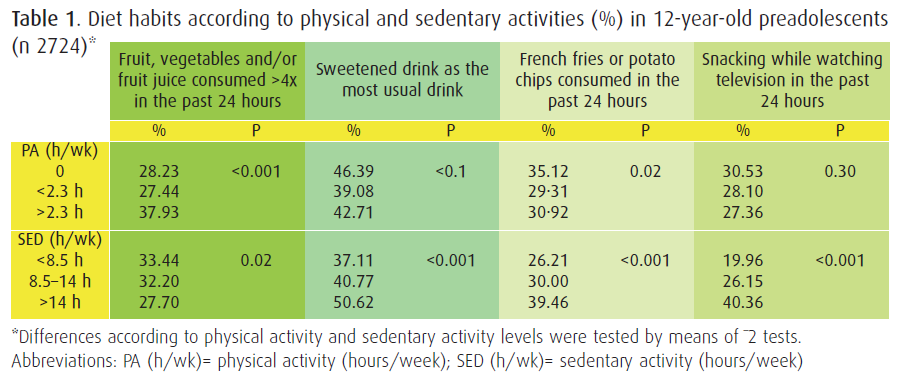There is a need for a better understanding of the relationships between healthy behaviours for more efficient prevention of noncommunicable diseases. Several studies have examined the relationships between various dietary behaviours and physical activity in children and adolescents, but none has used both physical activity and diet to investigate lifestyle patterns.
In 2001, Platat and colleagues investigated lifestyle patterns combining diet and physical activity in 12-year-old French preadolescents and studied their association with sociodemographic factors. Physical activity, sedentary activities and dietary habits were assessed by questionnaires in 2724 students. Family income tax and parental educational level, as indicators of socio-economic status, and the size of the household were obtained from parents.
Physical activity associated to fruit and vegetable consumption…
Table 1 presents the findings on dietary habits according to physical and sedentary activity. Physical activity was significantly and positively associated with fruit, vegetables and/or fruit juice being consumed more than four times in the previous 24 hours. It was inversely associated with sweetened drink consumption and with the consumption of French fries or potato chips in the previous 24 hours.
Time spent in sedentary activity was inversely associated with a high consumption of fruit, vegetables and/or fruit juice over the past 24 hours and positively and significantly associated with sweetened drink being the most commonly consumed drink, with the consumption of French fries or potato chips and with snacking while watching television, in the previous 24 hours.
… even after adjusting for socioeconomic factors
Even after adjusting for socio-economic status, physical activity remained significantly and positively associated with a consumption of fruit, vegetables and/or fruit juice on more than four occasions in the previous 24 hours. Nevertheless, the inverse association observed between physical activity and the consumption of French fries or potato chips did not remain significant when taking into account SES indicators.
Sedentary activities were significantly and positively associated with the consumption of French fries or potato chips, with sweetened drink as the most usual drink and with snacking while watching television, and inversely associated with a high consumption of fruit, vegetables and/or fruit juice.
Two distinct behavioural profiles
This study has identified two particular combinations of behaviour related to diet and physical activity. The first is defined by physical activity and the consumption of fruit, vegetables and/or fruit juice, and associated with the size of the household. The second is characterised by sedentary activity, the consumption of French fries or potato chips, sweetened drink as the most usual drink and snacking while watching television, and associated with family income tax and parental educational level.
The results suggest that physical and sedentary activities are distinct behaviours, associated with specific diet habits and also with different determinants.
Prevention programmes should focus on physical and sedentary activities
Recent work suggests that physical activity and sedentary behaviour may be determined by different parameters(1). Environmental factors, including the urban layout and density, availability of cycle paths, accessibility of sports facilities and proximity of food shops and fast-food outlets, have been identified as potential correlates of both physical activity and dietary habits(2).
Socioeconomic factors such as family income tax and parental educational level have been related to both dietary habits and physical activity(2,3). The sociodemographic determinants of physical activity and dietary habits may thus have contributed to their clustering. However, some activity patterns may favour specific dietary habits. This is the case for television-viewing and snacking(4), but it is reasonable to propose that regular exercise would also influence food choices.
The combinations of diet and physical activity habits identified in adolescents indicate that prevention programmes targeting both behavioural profiles may have a more effective outcome than focusing on each separately.

References
- Gordon-Larsen P et al. Pediatrics. 2000;105:E83.
- Popkin BM et al. Physiol Behav. 2005; 86:603–613.
- Drewnowski A & Specter SE. Am J Clin Nutr. 2004;79:6–16.
- Coon KA & Tucker KL. Minerva Pediatr. 2002;54:423–436.
